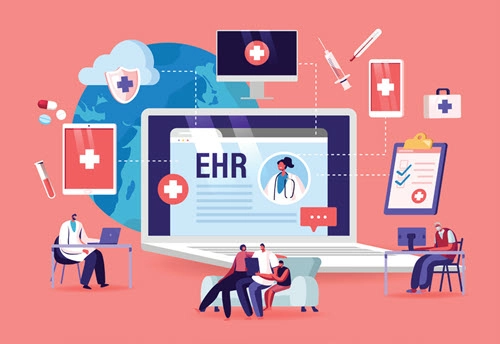Health Information Compliance Alert
Add These EHR-Related Acronyms to Your HIT Glossary
EHRs and public health reporting can thwart COVID-19.
If you work in a busy medical practice, then you know that there’s more to successfully managing electronic health records (EHRs) than click and return. In addition, vendor nuances often create technical road bumps that greatly impact data sharing, which can hurt patient outcomes down the line.
Now: On Sept. 29, the Department of Health and Human Services (HHS) instituted a new program to measure office-based physicians’ use of EHRs in coordination with the HHS Office of the National Coordinator for Health Information Technology (ONC) and the American Board of Family Medicine (ABFM), an HHS release suggests. Research shows that office-based physicians particularly suffer from certain IT-related burdens despite an 80 percent EHR-adoption rate. In fact, “only one in 10 of those physicians reported that they were able to electronically send, receive, find, and integrate health data from EHRs outside of their networks,” HHS says.
The collaborative effort aims to use the garnered research to tweak IT policy in future rulemaking.

Reminder: An EHR is a comprehensive, digital accounting of a patient’s health and treatment history. An EHR includes the myriad of specialists and services that a patient has seen and had over time — with all that accumulated clinical data in one place. Plus, EHRs collate patients’ data from other healthcare platforms, too, including hospitals, labs, diagnostic imaging providers, pharmacies, and more.
As part of the feds’ interoperability push, it’s essential that you know the ins and outs of EHR vernacular to keep on top of new developments, trends, and studies. You may want to consider adding these 10 terms to your digital dictionary:
1. CCD: The continuity of care document, or CCD for short, is “a joint effort of HL7 International and ASTM” and “fosters interoperability of clinical data by allowing physicians to send electronic medical information to other providers without loss of meaning and enabling improvement of patient care,” notes Health Level 7 International online guidance. More importantly, CCDs refer to summaries of patients’ health information, demographics, insurance, allergens, immunizations, and other clinical interactions to help with data exchanges during transitions of care from one organization to another. CCDs can also be incredibly helpful in community health, especially when disease spread needs to be tracked quickly.
2. CDR: If you’ve ever searched for critical information on a patient’s medical history, then you’ve likely accessed a clinical data repository (CDR). According to the National Library of Medicine, CDRs offer physicians a central location to research collected clinical data on patients as it offers a comprehensive view of information collated from a variety of IT systems.
3. CEHRT: The Centers for Medicare & Medicaid Services (CMS) requires providers to use health IT products that are certified and meet certain criteria to receive incentive payments through the Quality Payment Program (QPP) and the Promoting Interoperability (PI) programs. When an EHR has passed all of the CMS requirements, then it’s referred to as certified EHR technology (CEHRT), and organizations can use it to submit measures and in their IT attestations.
4. CPOE: Computerized provider order entry (CPOE) “refers to the process of providers entering and sending treatment instructions — including medication, laboratory, and radiology orders — via a computer application rather than paper, fax, or telephone,” according to ONC guidance. In the past, CPOEs were separate from EHR programs, but most EHR vendors offer products with this user-friendly feature as it increases patient safety and can even improve reimbursement from payers.

5. eCR: Electronic case reporting (eCR) is a critical EHR tool that allows providers to automatically generate and transmit case reports to public health agencies, which can be especially helpful in the midst of a public health emergency (PHE) like COVID-19. “eCR makes disease reporting from healthcare to public health faster and easier. It moves data securely and seamlessly — from the EHR at the point of care, to data systems at state, territorial, and local agencies. eCR also allows public health to provide information back to healthcare professionals,” explains the Centers for Disease Control and Prevention (CDC) eCR guidance.
6. ELR: Electronic lab reporting (ELR), the sister to eCR, refers to the electronic transmission of lab testing to public health agencies from EHRs. “ELR has many benefits, including improved timeliness, reduction of manual data entry errors, and reports that are more complete,” the CDC says.
7. EMR: Simply put, an electronic medical record (EMR) is just the digital version of patients’ charts created for a specific practice. It usually includes a patient’s medical history, the clinical and personal notes that the organization adds, and other important health information like diagnoses, treatments, surgeries, immunizations, and referrals.
8. eRx: If you utilize your organization’s EHR software to electronically prescribe medicine for your patients, then you are using eRx.
9. PHR: Personal health records (PHRs) follow along the same vein as EMRs and EHRs — but they are usually established and managed by patients. PHRs are often used by patients as a resource and can include medical and family histories, home monitoring statistics, and lists of specialists and visits.
10. PI programs: Back in 2011, CMS introduced the Medicare and Medicaid EHR Incentive programs to encourage healthcare professionals to use EHRs to improve their workflows and patient care. The adoption and implementation of CEHRT was originally referred to as Meaningful Use — until CMS renamed the initiative Promoting Interoperability (PI) programs in 2018 for Medicare Part A and Medicaid providers. Under the Merit-Based Incentive Payment System (MIPS), Part B clinicians attest their EHR updates through the PI category. As of 2020, all providers hoping for incentive pay through the programs are required to use 2015 Edition CEHRT.
Health Information Compliance Alert
- HIPAA Security:
Keep Track of Your IT Assets
Tip: Know the who, where, and why on practice mobile devices. Technology is a necessary [...] - Privacy:
Don’t Stomp on Employees’ Privacy Rights When Testing for COVID-19
Tip: Review both public health and labor updates frequently. If your organization is seeing patients [...] - Toolkit:
Add These EHR-Related Acronyms to Your HIT Glossary
EHRs and public health reporting can thwart COVID-19. If you work in a busy medical [...] - Enforcement News:
OCR Doubles Down As Third Quarter Ends
See details on 5 HIPAA Right of Access settlements. In 2019, the HHS Office for [...] - Reader Questions:
Know These HIPAA Facts on Electronic Signatures
Question: We are still seeing a majority of our patients via telehealth at our small [...] - Reader Questions:
PHI Is More Than Just Health Data
Question: Is there more to protected health information (PHI) than just a patient’s medical record [...]

